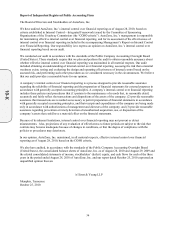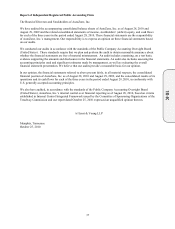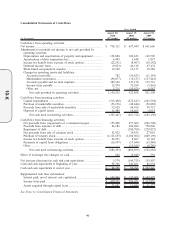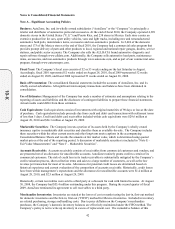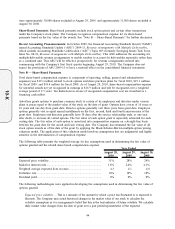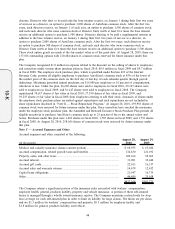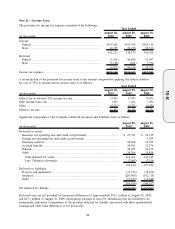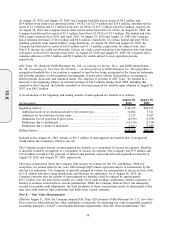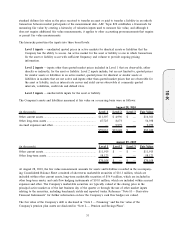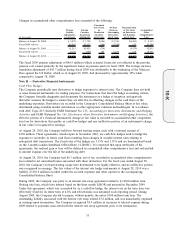AutoZone 2010 Annual Report Download - page 134
Download and view the complete annual report
Please find page 134 of the 2010 AutoZone annual report below. You can navigate through the pages in the report by either clicking on the pages listed below, or by using the keyword search tool below to find specific information within the annual report.
Deferred Rent: The Company recognizes rent expense on a straight-line basis over the course of the lease term,
which includes any reasonably assured renewal periods, beginning on the date the Company takes physical
possession of the property (see “Note M – Leases”). Differences between this calculated expense and cash
payments are recorded as a liability in accrued expenses and other and other long-term liabilities in the
accompanying Consolidated Balance Sheets. Deferred rent approximated $67.6 million as of August 28, 2010,
and $59.2 million as of August 29, 2009.
Financial Instruments: The Company has financial instruments, including cash and cash equivalents, accounts
receivable, other current assets and accounts payable. The carrying amounts of these financial instruments
approximate fair value because of their short maturities. A discussion of the carrying values and fair values of the
Company’s debt is included in “Note I – Financing,” marketable securities is included in “Note F – Marketable
Securities,” and derivatives is included in “Note H – Derivative Financial Instruments.”
Income Taxes: The Company accounts for income taxes under the liability method. Deferred tax assets and
liabilities are determined based on differences between financial reporting and tax bases of assets and liabilities
and are measured using the enacted tax rates and laws that will be in effect when the differences are expected to
reverse. Our effective tax rate is based on income by tax jurisdiction, statutory rates, and tax saving initiatives
available to us in the various jurisdictions in which we operate.
The Company recognizes liabilities for uncertain income tax positions based on a two-step process. The first step
is to evaluate the tax position for recognition by determining if the weight of available evidence indicates that it is
more likely than not that the position will be sustained on audit, including resolution of related appeals or
litigation processes, if any. The second step requires us to estimate and measure the tax benefit as the largest
amount that is more than 50% likely to be realized upon ultimate settlement. It is inherently difficult and
subjective to estimate such amounts, as the Company must determine the probability of various possible
outcomes. The Company reevaluates these uncertain tax positions on a quarterly basis or when new information
becomes available to management. These reevaluations are based on factors including, but not limited to, changes
in facts or circumstances, changes in tax law, successfully settled issues under audit, expirations due to statutes,
and new audit activity. Such a change in recognition or measurement could result in the recognition of a tax
benefit or an increase to the tax accrual.
The Company classifies interest related to income tax liabilities as income tax expense, and if applicable, penalties
are recognized as a component of income tax expense. The income tax liabilities and accrued interest and
penalties that are due within one year of the balance sheet date are presented as accrued expenses and other in the
accompanying Consolidated Balance Sheets. The remaining portion of the income tax liabilities and accrued
interest and penalties are presented as other long-term liabilities in the accompanying Consolidated Balance
Sheets because payment of cash is not anticipated within one year of the balance sheet date.
Sales and Use Taxes: Governmental authorities assess sales and use taxes on the sale of goods and services. The
Company excludes taxes collected from customers in its reported sales results; such amounts are reflected as
accrued expenses and other until remitted to the taxing authorities.
Revenue Recognition: The Company recognizes sales at the time the sale is made and the product is delivered to
the customer. Revenue from sales are presented net of allowances for estimated sales returns, which are based on
historical return rates.
A portion of the Company's transactions include the sale of auto parts that contain a core component. The core
component represents the recyclable portion of the auto part. Customers are not charged for the core component of
the new part if a used core is returned at the point of sale of the new part; otherwise the Company charges
customers a specified amount for the core component. The Company refunds that same amount upon the customer
returning a used core to the store at a later date. The Company does not recognize sales or cost of sales for the
core component of these transactions when a used part is returned or expected to be returned from the customer.
Vendor Allowances and Advertising Costs: The Company receives various payments and allowances from its
vendors through a variety of programs and arrangements. Monies received from vendors include rebates,
allowances and promotional funds. The amounts to be received are subject to the terms of the vendor agreements,
which generally do not state an expiration date, but are subject to ongoing negotiations that may be impacted in
44
10-K




